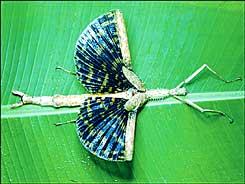Research on insects raises the possibility that complex organs that disappeared during evolution may reappear
Carol Kesok Yoon

McCluney. Loss of a complex organ is considered an "evolutionary impasse"
The fluttering wings of insects are a delicate, strong and precise wonder, and they are considered one of the main innovations that allowed insects to become the rulers of the current era. The nerves and muscles of these flight structures are extremely complex, and entomologists have long assumed that when an insect lineage loses its wings during evolutionary development, its descendants will not be able to reacquire the intricately-mechanized organ.
And so, when an international team of researchers reported in the latest issue of the journal "Nature" that insects from the Mecloni series have re-grown wings at least four times during their evolution - the researchers' reaction was a complete surprise. "When I presented these results to entomologists," said Dr. Michael Whiting, an evolutionary biologist at Brigham Young University and lead author of the paper, "the response was, 'No way, no way, no way.'" Some scientists, Whiting recalled, said it was such a ridiculous idea that no amount of evidence would convince them to accept it.
The new research confuses entomologists as much as it fascinates evolutionary biologists, because it raises the possibility that not only wings but any complex organ, such as limbs or eyes, that might disappear during evolution, can re-evolve. "The thinking has always been that this kind of loss is essentially an evolutionary dead end," said Dr. Joel Kingsolver, an evolutionary biologist at the University of North Carolina.
The prevailing assumption among researchers was that when the ancestors of the winged insects evolved into the first lineages of the meclones, these lineages had wings. According to this hypothesis, the Maklonians lost their wings only in later lineages, which stopped developing from an evolutionary point of view. But when the researchers used the DNA sequences to reconstruct the family tree of the Maklonians, they discovered the opposite - all the ancient groups were wingless. This means that the winged bats evolved later.
"I had an undergraduate student working on the project," said Dr. Whiting. "I was sure he had it all mixed up," but when the researchers checked his work, they found that the results were valid.
Researchers have difficulty accepting the research because, according to the example of the theory of evolution, after the wings have degenerated, the genetic mechanisms for their construction are supposed to no longer be subject to the process of natural selection. According to this thinking, these genes should undergo mutations that eliminate their ability to produce the necessary equipment for flight.
Some researchers said that the findings raise the possibility that the genetic mechanism continued to exist in the McCalonians covertly, perhaps because this mechanism is involved in the development of organs that the wingless insects continue to grow, such as legs.
What could be the reason for the disappearance of the wings in the ancient Maklonians? Researchers hypothesize that for a creature whose only desire is to resemble a dead branch, flight is not the most viable behavior. According to this hypothesis, wings might have re-evolved when the need arose to occasionally abandon botanical camouflage, to fly in search of new food sources or distant mates.
New York Times
